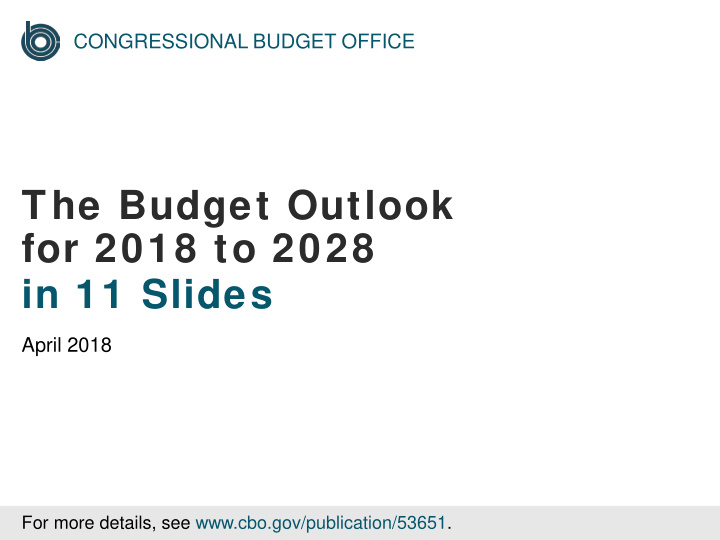



CONGRESSIONAL BUDGET OFFICE The Budget Outlook for 2018 to 2028 in 11 Slides April 2018 For more details, see www.cbo.gov/publication/53651.
CBO Deficits as a percentage of gross domestic product are projected to increase over the next few years and then largely stabilize. They exceed their 50-year average throughout the 2018–2028 period. 1
CBO Under current law, revenues and outlays would increase in most years through 2028, and the gap between them would remain large. 2
CBO The Outlook for Revenues 3
CBO Under current law, total revenues are projected to rise as a share of GDP largely because of scheduled changes in tax provisions, wage growth, the taxation of individual income at higher rates when incomes rise faster than inflation, and growing distributions from tax-deferred retirement accounts. 4
CBO Individual income tax revenues rise sharply following the expiration of temporary provisions of the 2017 tax act at the end of 2025. 5
CBO The Outlook for Spending 6
CBO Under current law, rising spending for Social Security and Medicare would boost mandatory outlays . At the same time, growing debt and higher interest rates are projected to push up net interest costs. 7
CBO CBO’s projections of discretionary spending incorporate budgetary caps through 2021 and the assumption that discretionary budget authority grows with inflation thereafter. In those projections, discretionary budget authority is boosted in the near term by recent legislation but then declines by 8 percent in 2020 because of scheduled reductions to the caps. 8
CBO The Outlook for Debt 9
CBO Federal debt held by the public rises from 78 percent of GDP (or $16 trillion) at the end of 2018 to 96 percent of GDP (or $29 trillion) by 2028 in CBO’s projections. That percentage would be the largest since 1946 and well more than twice the average over the past five decades. 10
CBO CBO also analyzed an alternative fiscal scenario in which current law was altered to maintain major policies—so that substantial tax increases and spending cuts would not take place as scheduled under current law—and to provide more typical amounts of emergency funding than the sums provided for 2018. In that scenario, debt held by the public would reach about 105 percent of GDP by the end of 2028. 11
CBO About This Document For more details about CBO’s budget projections as well as the agency’s most recent economic forecast, see The Budget and Economic Outlook: 2018 to 2028 (April 2018), www.cbo.gov/publication/53651. That report is the result of work by many analysts at CBO. 12
Recommend
More recommend